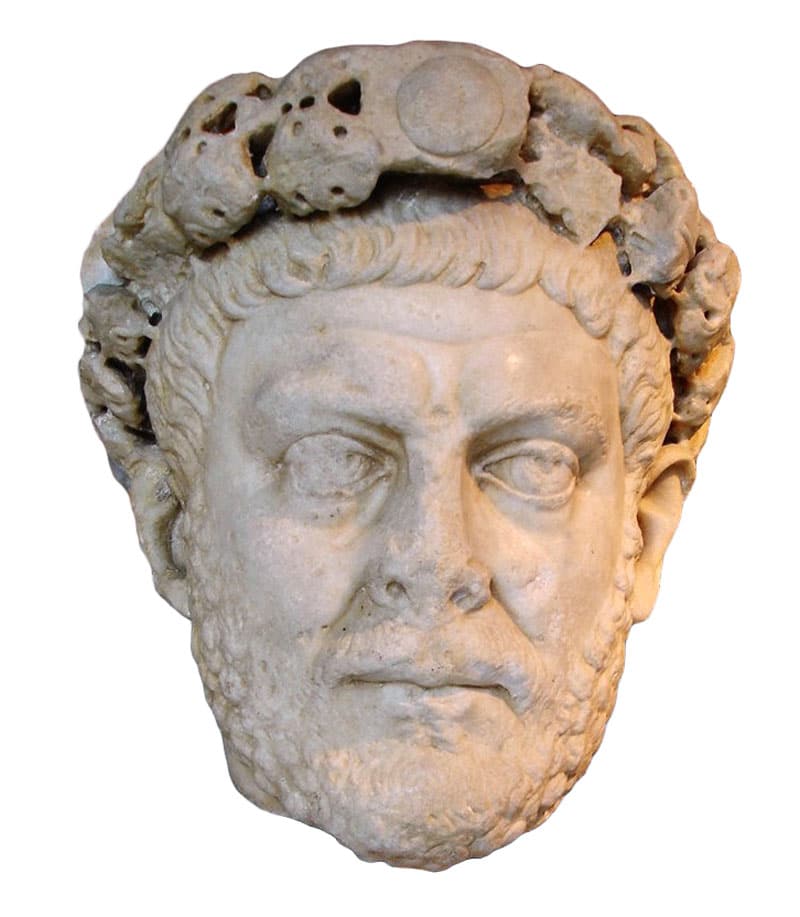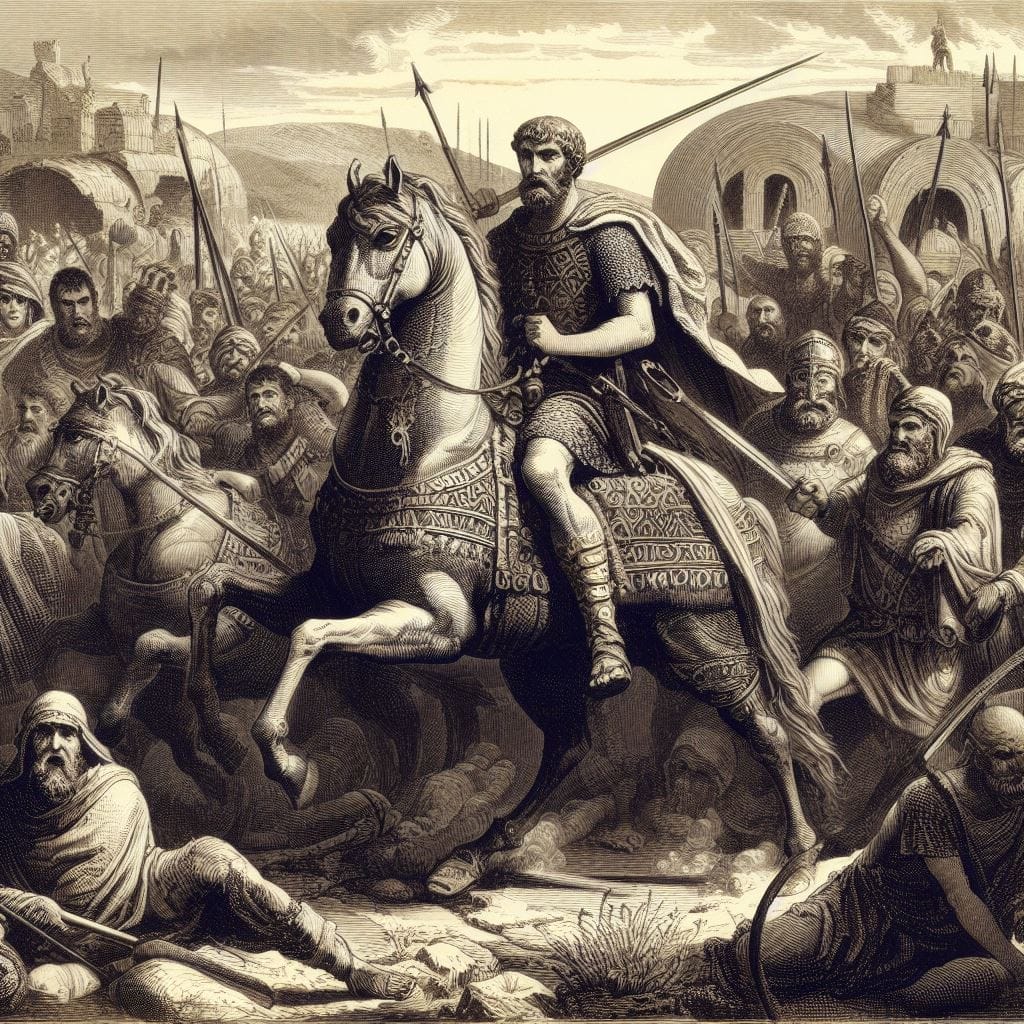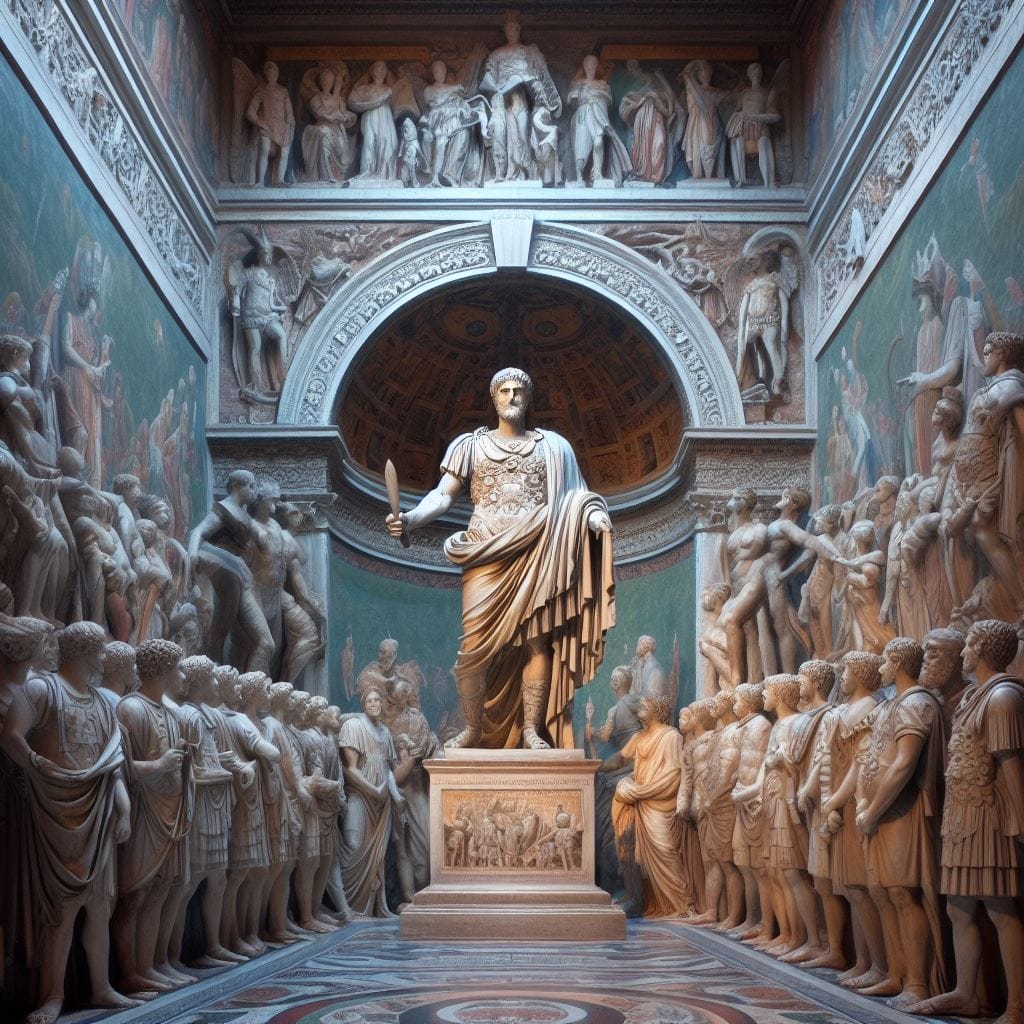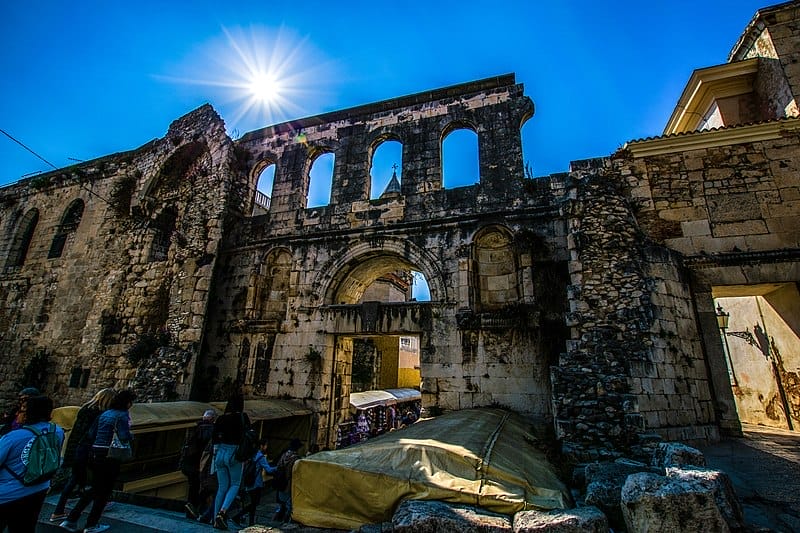Life: AD 240 – 311

- Name: Gaius Aurelius Valerius Diocletianus
- Born 22 December AD 240.
- Consul AD 284, 285, 287, 290, 293, 296, 299, 303, 304, 308.
- Became emperor on 20 November AD 284.
- Wife: Prisca (one daughter; Galeria Valeria).
- Died at Spalatum, 3 December AD 311.
Diocletian’s Early Life
Born probably near Spalatum (Split) with the name Diocles on 22 December AD 240 or 245, he was the son of a poor family in Dalmatia. It is said that his father, apparently a scribe of a wealthy senator, might have been a former slave.
Diocles rose through the ranks of the military and achieved a high position. Throughout the AD 270s, he was a military commander in Moesia. From AD 283 onwards, under Carus and his son and successor Numerian, he acted as commander of the imperial bodyguard (protectores domestici) and appeared a rather dubious figure in the deaths of both of those emperors. In November AD 284, near Nicomedia, he was chosen by the soldiers to avenge Numerian’s death, which he did by charging Arrius Aper, the praetorian prefect, whom he sentenced to death. Thereafter, he personally executed Aper in front of the troops.
Becoming an Emperor
Hailed emperor on 20 November AD 284, immediately or shortly after this execution, Gaius Aurelius Valerius Diocletian – the name he assumed with the imperial title – crossed the Bosporus into Europe and met the forces of Numerian’s brother and co-emperor Carinus at Margum on 1 April AD 285.
Diocletian was, in fact, losing the battle as the assassination of Carinus by one of his own officers left the opposing army without a leader. With only one imperial candidate still left on the field, Carinus’ army surrendered, accepting Diocletian as emperor.
Carinus’ murder would also suggest a possible involvement by Diocletian, connecting him (although solely by rumor) with the possible assassination of three emperors. Seeing it necessary to display goodwill to the supporters of Carinus, Diocletian kept Carinus’ praetorian prefect, Aristobolus, as well as keeping many of the former emperor’s government officials in place.
Then, much to everyone’s surprise, Diocletian, in November AD 285, appointed his own comrade Maximian as Caesar and granted him control over the western provinces. Surprising as this development no doubt was, Diocletian urgently needed to give the problems on the Danubian borders his full attention. Meanwhile, he needed someone in Rome to take care of the government. Not having a son, it was a natural choice to pick one of his trusted military comrades to hold the fort for him.
With Maximian proving himself a worthy Caesar, Diocletian, only several months later, on 1 April AD 286, promoted him to the rank of Augustus. Diocletian, however, remained the senior ruler, possessing a veto over any edicts made by Maximian.
The year Ad 286, however, should not only be remembered for the promotion of Maximian. It also should become known for the rebellion of Carausius, who was the commander of the North Sea fleet and made himself emperor of Britain.
Campaigning against Germans and Sarmatians
Meanwhile, Diocletian embarked on several years of hard campaigning. Mostly along the Danube frontier, where he defeated German and Sarmatians tribes. One expedition took him as far as Syria, where he campaigned against the Saracen invaders from the Sinai peninsula in AD 290.

Then, in AD 293, Diocletian took another huge step into the unknown by founding the ‘Tetrarchy’, the rule of four. This entirely new idea of imperial government meant that four emperors should rule the empire. Two Augusti would rule as major emperors, one in the east, the other in the west. Each Augustus would adopt as his son a junior emperor, a Caesar, who would help rule his half of the empire with him and who be his appointed successor. The two men who were appointed to these positions were Constantius and Galerius, both military men of Danubian origin.
Had the empire been divided before then, Diocletian’s division was far more systematic. Each of the tetrarchs had his own capital city in a territory under his control. The idea was to create a system by which heirs to the throne were appointed by merit and would rule as Caesars long before the place of Augustus would become vacant. They would then be the automatic heir to the throne and would appoint the next Caesar by merit. So, in theory, at least, this system would ensure that the best men for the job ascended to the throne. The tetrarchy did not officially split the empire into east and west. It remained one unit but was ruled by four men.
The Persian Invasion
In AD 296, the Persians attacked the empire. Their successes inspired the revolt of Lucius Domitius Domitianus, after whose death Aurelius Achilleus succeeded as ’emperor’ of Egypt. Diocletian moved to put down the revolt, and in early AD 298, Achilleus was defeated and killed at Alexandria. Meanwhile, Galerius, the eastern Caesar being groomed to succeed Diocletian, successfully campaigned against the Persians.
Under Diocletian, the imperial court was much expanded and elaborated. People were to kneel before their emperor, kissing the hem of his robes. All this was no doubt introduced to yet further increase the authority of the imperial office. Under Diocletian, the emperor became a god-like creature, detached from the worldly affairs of the lesser people around him.
It is considering these intentions that one must regard Diocletian and Maximian declaring themselves the respective sons of Jupiter/Jove and Hercules. This spiritual link between them and the gods, Diocletian adopting the title Jovianus and Maximian, the one of Herculianus, was to further elevate them and set them apart from the world around them. No previous emperor had ever gone so far. But it was the pagan equivalent of the ruling ‘by the will of God’, which Christian emperors were to do in years to come.
If Diocletian elevated his own position, then he further reduced the power of the provincial governors. He doubled the number of provinces to 100. Controlling only such small areas, it was almost impossible now for a governor to launch a rebellion. To help oversee this patchwork of little provinces, thirteen dioceses were created, which acted as regional authorities over the provinces. These dioceses were each ruled by a vicarius. In turn, the vicar was controlled by the four main administrators of the empire, the praetorian prefects (one praetorian prefect per tetrarch).
The administration of government was largely left in the hands of the prefects. They were no longer really military commanders, but they were expert jurists and administrators overseeing imperial administration. Were Diocletian’s reforms indeed far-reaching, then one of their effects was to significantly reduce the power of the senate. This, no doubt, will not have been a coincidence.
Diocletian Reforms
If Diocletian reformed the way the empire was governed, then he did not stop there. First and foremost, the conscription for Roman citizens was reintroduced. The army also was significantly changed in the way it operated. The forces were divided into two parts. One part was the frontier troops guarding the borders, the limitanei, the other, highly mobile forces stationed inland, away from the immediate frontiers, and who could rush to any trouble spot, were the comitantenses. Further, the fleet was expanded.
This expansion of the military under Diocletian represented a large increase compared to the previous reigns. With now well over half a million men under arms, as well as a struggling economy, the tax burden was becoming hard to bear for the ordinary population.
Diocletian’s government, though, was well aware of this. Under his administration, a complex taxation system was created, which allowed for regional variations of harvests and trade. Areas with more fertile soil or wealthier trade were hence taxed harder than poorer regions.
The Edict of Maximum Prices
In AD 301, the Edict of Maximum Prices imposed throughout the empire tried to fix prices and wages in order to curb inflation. The system, however, did more damage than it did good. Regional price variations no longer existed, and therefore, trade suffered. Many goods also became unprofitable to sell, which therefore also meant that trade in those goods simply disappeared.
But Diocletian, the great reformer of the empire, should also become known for a very harsh persecution of the Christians. Trying to strengthen Roman traditions, he revived the worship of the old Roman gods. The foreign cults, however, he had no time for. In AD 297 or 298, all soldiers and administrators were ordered to make sacrifices to the gods. Anyone who refused to do so was immediately dismissed.

On 24 February AD 303 another edict was issued. This time Diocletian ordered the destruction of all churches and scriptures within the empire. More edicts followed that year, ordering all Christian clergy to be thrown in prison, to be released only after having made sacrifice to the Roman gods.
In April AD 304, Diocletian issued his final religious edict. All Christians were ordered to Roman gods. Anyone who would refuse would be executed. Then, after a serious illness, in AD 304, he took a step – unimaginable to Romans – of abdicating from the throne on 1 May AD 305, compelling a reluctant Maximian to do the same.

From his place of retirement at Spalatum (Split) in Dalmatia, Diocletian briefly returned to the political scene in AD 308 to aid Galerius at the Conference of Carnuntum. After this he withdrew back to Spalatum, where he died on 3 December AD 311.

Diocletian’s Palace, located in the heart of Split, Croatia, stands as a monumental testament to Roman architectural ingenuity and the historical depth of the Adriatic coastline. Constructed at the turn of the fourth century AD, around 305, this imposing structure was originally built as a retirement residence for the Roman Emperor Diocletian. Today, it is one of the most complete architectural and cultural features on the Croatian Adriatic coast, and it holds an esteemed place on UNESCO’s World Heritage List.
The palace is a unique structure, both in scale and in preservation, blending the luxurious villa with the qualities of a military camp. Covering a rectangular area of approximately 215 x 180 meters, it combines the features of a luxurious villa with those of a military camp, divided into four parts by two main streets. The complex includes various residential and public buildings, temples, and the emperor’s apartments.
One of the most striking features of Diocletian’s Palace is its ability to adapt over centuries. After the fall of the Roman Empire, the palace gradually transformed into a town, incorporating shops, houses, and churches, including the Cathedral of Saint Domnius, which was originally Diocletian’s Mausoleum. This blend of ancient and medieval architecture gives the palace its unique character and demonstrates the layers of history within its walls.
The architecture of Diocletian’s Palace reflects the Roman architectural tradition, with influences from Greek and Egyptian culture, as seen in the Sphinxes Diocletian brought from Egypt to adorn the palace. The preservation of this historical site allows visitors to walk through ancient Roman streets, explore the remains of the luxurious imperial quarters, and marvel at the well-preserved cellars that once supported the emperor’s private apartments.
Over the years, Diocletian’s Palace has attracted scholars, tourists, and history enthusiasts, intrigued by its historical significance and architectural beauty. It serves not only as a monument to Diocletian’s rule but also as a living monument, with over 3,000 people residing within its walls, making it a unique example of a historical monument integrated into the daily lives of a modern city.
The legacy of Diocletian’s Palace is a testament to the Roman Empire’s vast reach and the enduring appeal of Roman architecture. It remains a pivotal site for understanding the cultural and historical layers of Europe, reflecting the Roman Empire’s sophistication, power, and influence in the region. The palace not only commemorates Diocletian’s reign but also symbolizes the blend of past and present, offering a window into the ancient world while serving as a vibrant part of contemporary Split.
People Also Ask:
What is Emperor Diocletian famous for?
Diocletian separated and enlarged the empire’s civil and military services and reorganized the empire’s provincial divisions, establishing the largest and most bureaucratic government in the history of the empire.
Why was Diocletian a bad emperor?
Although Diocletian was a capable military commander and implemented significant administrative reforms, his reign was marred by his brutal persecution of Christians. As a staunch defender of the traditional Roman religion, Diocletian believed that Christians undermined the empire’s stability.
What religion was Diocletian?
Diocletian, acclaimed emperor on November 20, 284, was a religious, conservative, faithful to the traditional Roman cult. Unlike Aurelian (r. 270–275), Diocletian did not foster any new cult of his own. He preferred the older Olympian gods.
Why did Emperor Diocletian split the empire?
The Tetrarchy (“rule of four”) was created by Diocletian in 293 CE. In the third century, the Roman Empire had grown too large and impossible to administer. To solve this problem, Diocletian divided the Roman Empire into four distinct territories, each to be governed by a different ruler.
How did Diocletian fall out of power?
Although effective while he ruled, Diocletian’s tetrarchic system collapsed after his abdication under the competing dynastic claims of Maxentius and Constantine, sons of Maximian and Constantius, respectively.

Historian Franco Cavazzi dedicated hundreds of hours of his life to creating this website, roman-empire.net as a trove of educational material on this fascinating period of history. His work has been cited in a number of textbooks on the Roman Empire and mentioned on numerous publications such as the New York Times, PBS, The Guardian, and many more.
